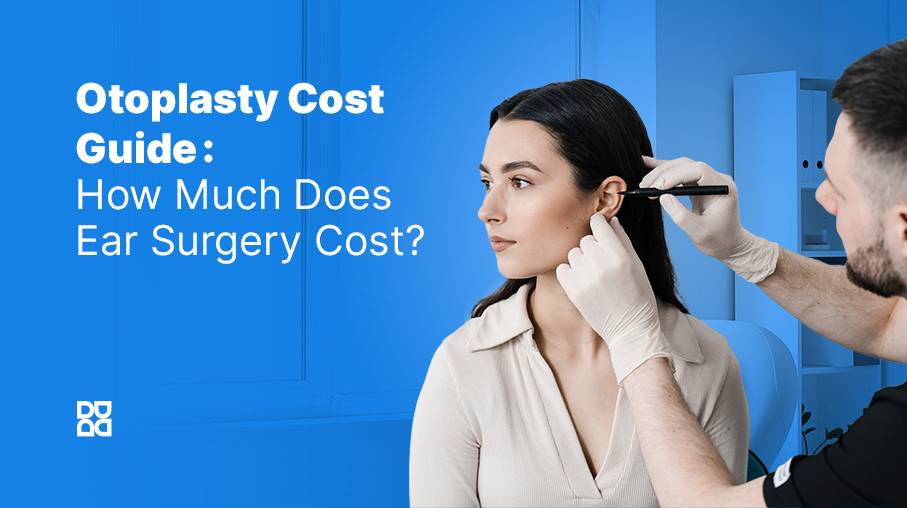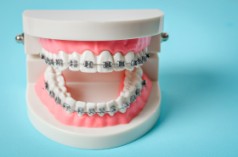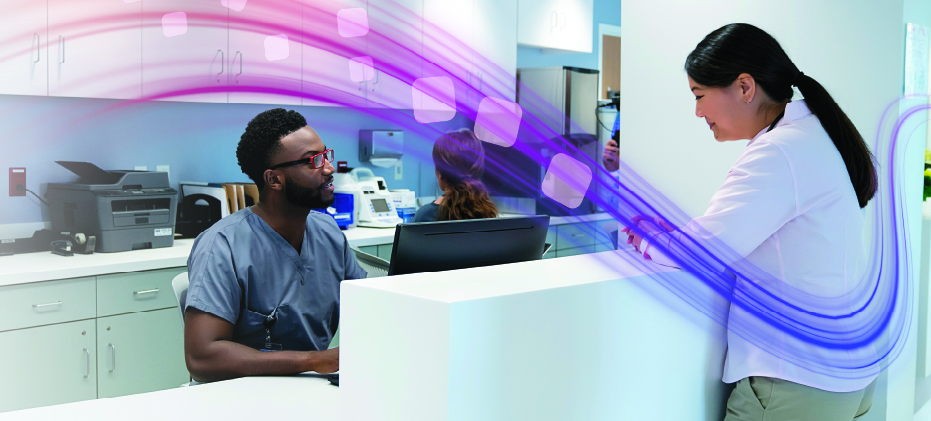In a Nutshell Dermatomes are specific areas of the skin supplied by individual spinal nerves. They help doctors and other healthcare providers trace symptoms like tingling, pain, or numbness back to the nerve root involved. This blog covers everything you should know about dermatomes, including: A full dermatome map from head to toe. Detailed breakdowns … Continued The post Dermatomes: Your Simple Guide to the Nerve Map on Your Skin first appeared on Denefits.
In a Nutshell
Dermatomes are specific areas of the skin supplied by individual spinal nerves. They help doctors and other healthcare providers trace symptoms like tingling, pain, or numbness back to the nerve root involved. This blog covers everything you should know about dermatomes, including:
- A full dermatome map from head to toe.
- Detailed breakdowns of the cervical, thoracic, lumbar, and other types of dermatomes.
- A spotlight on hand dermatomes, leg dermatomes, and facial dermatomes.
- How dermatomes help diagnose health conditions like shingles, nerve injuries, and herniated discs.
- Frequently asked questions about dermatomes to make complex terms easy to understand.
- How Denefits can help you access treatment for dermatome-related conditions with flexible and no-credit-check payment plans.
If you’ve ever experienced pain, tingling, or numbness in a particular patch of your skin and wondered what’s causing it, it’s time to introduce yourself to dermatomes. Dermatomes are areas on your body that depend on specific spinal nerves. The nerves carry all the signals transmitted between your brain and the dermatome.
Whether you have a pinched nerve, sciatica, or shingles, learning about dermatomes helps you identify and manage your symptoms. This guide simplifies the concept of dermatomes with patient-friendly explanations, charts, and visuals. We will also discuss the most convenient way to pay medical bills if you undergo treatment for dermatome-related conditions.
Dermatomes and Myotomes: What’s the Difference and Why Do They Matter?
Think of your skin like a large map, and your spine as the center of control. Every section of your spine sends signals to specific skin parts through your nerves. These parts of your skin are defined as dermatomes.
Therefore, a dermatome is simply a patch on your skin that feels touch, pain, or temperature from one single spinal nerve.
Real Life Example:
Let’s say you have a pinched nerve in your back, but you’re feeling tingling or numbness in one of your legs. That’s because the particular nerve in your back connects to the dermatome covering the affected leg. So, the problem starts at the spinal nerve root, but you experience the symptoms at the far end of the nerve’s path. This is called referred pain or radiculopathy.
Now, myotomes are the muscle zones controlled by the same spinal nerves. A myotome is a group of muscles that gets movement instructions from one specific nerve in your spinal system.
Real Life Example:
Suppose you have some trouble lifting your foot. Your muscles in the affected area might be weak. So, your doctor may test the strength of those particular muscles and figure out which spinal nerve is injured. That’s because those muscles are a part of a specific myotome.
Myotomes and Dermatomes: A Comparison
Here’s how to differentiate myotomes and dermatomes based on different features:
| Feature | Dermatomes | Myotomes |
| What it is | Area of skin connected to a specific spinal nerve | A group of muscles controlled by a specific spinal nerve |
| Function | Transmit sensory information (like touch, pain, temperature) from the skin to the brain | Transmit motor signals from the brain to the muscles to control movement |
| Example | Tingling or numbness in a specific skin patch (e.g., shingles follows a dermatome) | Weakness in certain muscles when a specific spinal nerve is affected |
| Location Mapping | Organized in a “strip-like” pattern across the body | Organized based on muscle groupings, not as visually mapped |
| Used For Diagnosis | Nerve root damage causing sensory changes | Nerve root damage causing muscle weakness or paralysis |
| Common Tests | Pinprick, temperature, or light touch tests on the skin | Strength or movement tests (e.g., resisting push or pull) |
| Clinical Relevance | Helps detect nerve compression, infection (like shingles) | Helps identify spinal cord injuries, nerve root compression |
Why They Matter
Here are a few points covering the significance of both dermatomes and myotomes present throughout the body.
| Significance | Dermatomes | Myotomes |
| Identifying Nerve Issues | Show which spinal nerve is causing pain, tingling, or numbness on the skin | Show which spinal nerve is causing muscle weakness or difficulty moving |
| Diagnostic Use | Used to diagnose issues like shingles, slipped discs, or spinal injuries | Used to assess paralysis, spinal cord damage, or nerve root compression |
| Clinical Application | Guide doctors when giving nerve blocks or epidurals | Help therapists plan rehab exercises and recovery plans |
Dermatome Map: How Your Spinal Nerves Connect to Your Skin
Your skin is an integral part of your well-organized body. Underneath your skin, the spinal nerves act as messengers to carry information such as touch, pain, hot or cold sensations, etc., to your brain.
Each dermatome in your body is connected to a spinal nerve, and a dermatome map will help you understand how dermatomes are arranged from your head down to your feet. For example, a nerve from your lower back may be connected to your thigh or foot, and another nerve from your neck may link to your shoulder.
Figure: Dermatomal Distribution Throughout the Body
Here is a dermatome map illustrating how your nervous system is organized beneath your skin.
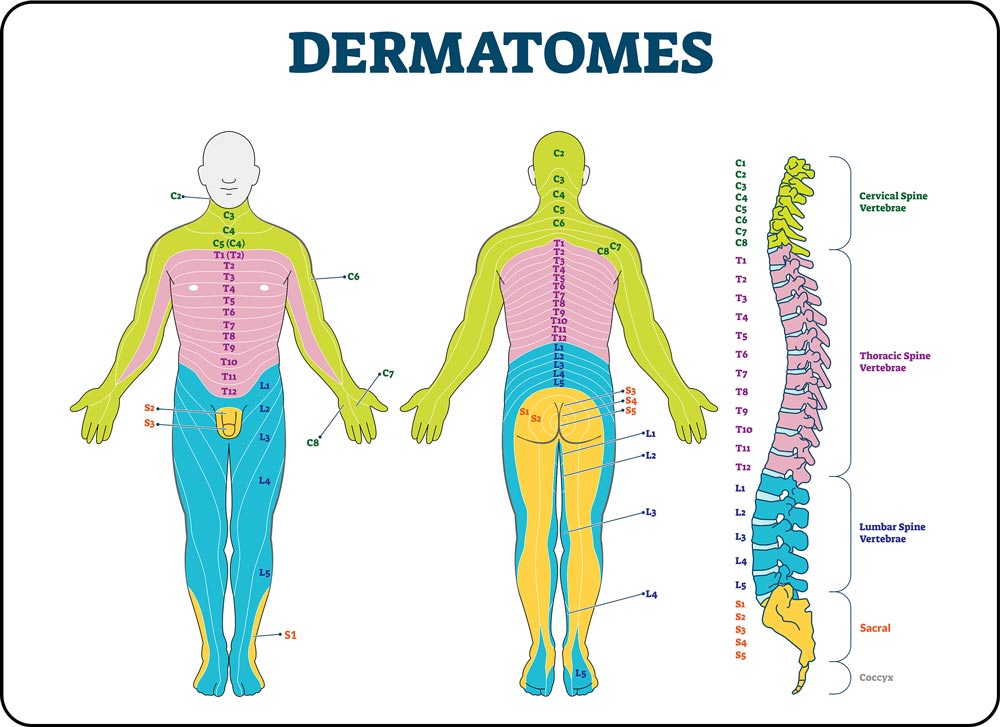
Significance of the Dermatomal Map
- This dermatomal map helps healthcare professionals diagnose and treat nerve issues with high accuracy.
- It also allows them to pinpoint the location of spinal cord injuries or compressions.
- Using a dermatome map, clinicians can assess and diagnose many conditions, including injuries, cysts, tumors, and infections.
- It is used during surgical planning to identify which dermatomal levels should be blocked to perform the surgery.
Spinal Nerve Chart Explained: Your Body’s Wiring Blueprint
A spinal nerve chart is like the wiring diagram of your body. It demonstrates how spinal nerves branch out from the spinal cord and connect to specific parts of the skin across the body. The spinal nerves are numbered from the neck (cervical spine) down to the tailbone (sacral spine). Here’s a breakdown for simpler understanding:
| Spinal Nerve Region | Nerve Roots | Areas Controlled |
| Cervical Nerves | C1 – C8 | Neck, shoulders, arms, hands, and parts of the head |
| Thoracic Nerves | T1 – T12 | Chest, upper back, and abdomen |
| Lumbar Nerves | L1 – L5 | Hips, thighs, knees, and inner legs |
| Sacral Nerves | S1 – S5 | Back of the legs, feet, and pelvic region |
| Coccygeal Nerves | Co1 | Coccyx and anal region |
A Closer Look at the Spinal Nerve Map
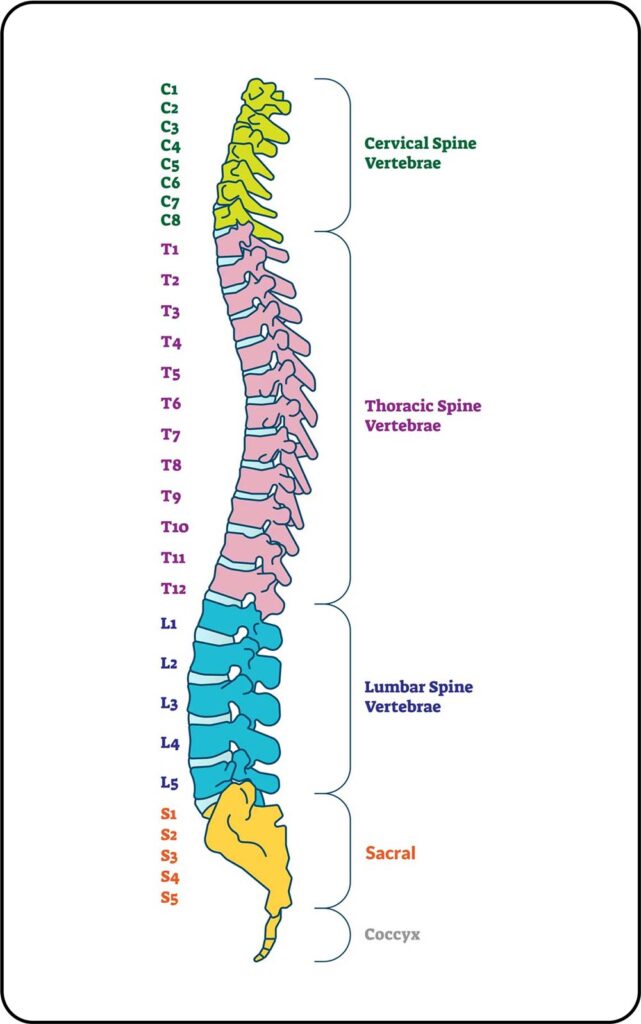
Now, let’s explore each section of the spinal nerve map in detail to understand its role and significance.
Cervical Dermatomes: Understanding Neck, Shoulder & Arm Sensations
Cervical dermatomes are those areas of the skin supplied by the nerves originating from the cervical (neck) region of the spinal cord. This category includes the C2, C3, C4, C5, C6, C7, and C8 dermatome. Let us find out more about each of these:
➡️ C2 Dermatome: Back of Head Sensation
The C2 dermatome covers your upper neck and the back of your head. If this nerve is irritated, you may feel tingling, burning, or pain in those areas. The C2 dermatome is often linked with headaches originating at the base of the skull. This dermatome doesn’t affect your face, as it’s controlled by other nerves.
➡️ C3 Dermatome: Side of Neck Sensation
The C3 dermatome encompasses the side of your neck, the area right under your jaw. If this area feels tingly, sore, or numb, it could be due to this dermatome. Injuries like whiplash or medical conditions in the upper neck can affect C3. It often works together with the surrounding nerves to send signals from your neck.
➡️ C4 Dermatome: Upper Shoulder and Collarbone Sensation
The C4 dermatome expands over the top of your shoulder and collarbone area. If you experience pain or discomfort around this area, the C4 dermatome might be affected. It can be triggered by neck strain or problems in the upper spine. You may feel an ache while lifting your arms or moving your neck.
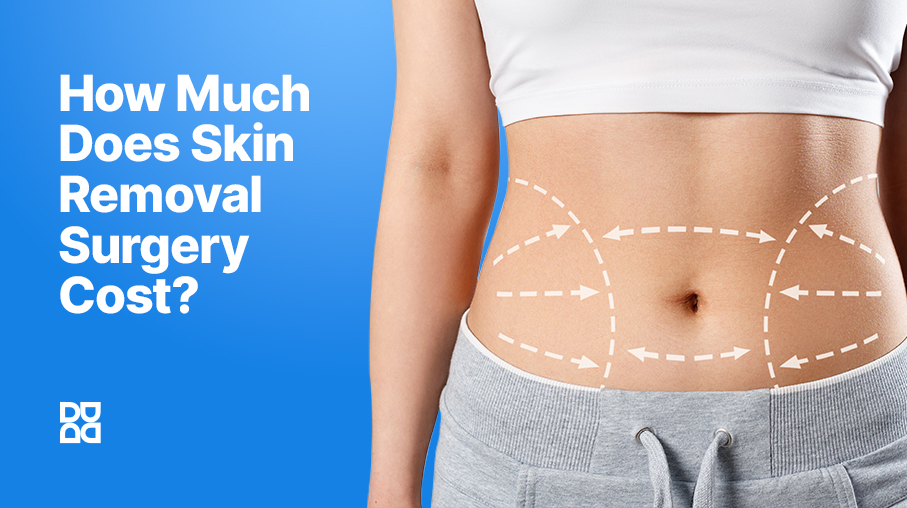
Wondering If Skin Removal Surgery Fits Your Budget?
We’ve crunched the numbers (and included financing options too).
➡️ C5 Dermatome: Outer Shoulder Sensation
The C5 dermatome extends down the forearm and lateral arm up to the base of the thumb. Sensations like numbness, pain, or tingling in these regions may arise due to issues with this dermatome. It helps with movements like raising your arm or lifting lightweight objects.
➡️ C6 Dermatome: Outer Forearm and Thumb Sensation
The C6 dermatome covers the thumb of the forearm and the radial side of the hand. Pain or tingling in these areas may indicate issues with the C6 dermatome. This nerve regulates movements, including bending your elbow or twisting your wrist. It is also one of the most common nerves affected by neck problems.
➡️ C7 Dermatome: Central Palm and Middle Finger Sensation
The C7 dermatome encompasses the middle finger and the posterior region of the arm and forearm. A “pins and needles” feeling, numbness, or pain in your middle finger may arise from this dermatome. C7 helps control pushing movements like straightening your arm. A slipped disc in the middle of your neck can put pressure on this nerve.
➡️ C8 Dermatome: Ring and Pinky Finger Sensation
The C8 dermatome innervates the ring finger and little finger, covering the medial side of the arm and forearm. C8 may be involved if you feel discomfort in these particular areas. It helps with hand movements, including gripping, typing, buttoning clothes, etc. Pressure on this nerve can make your hand feel weak or clumsy.
Cervical Dermatome Chart
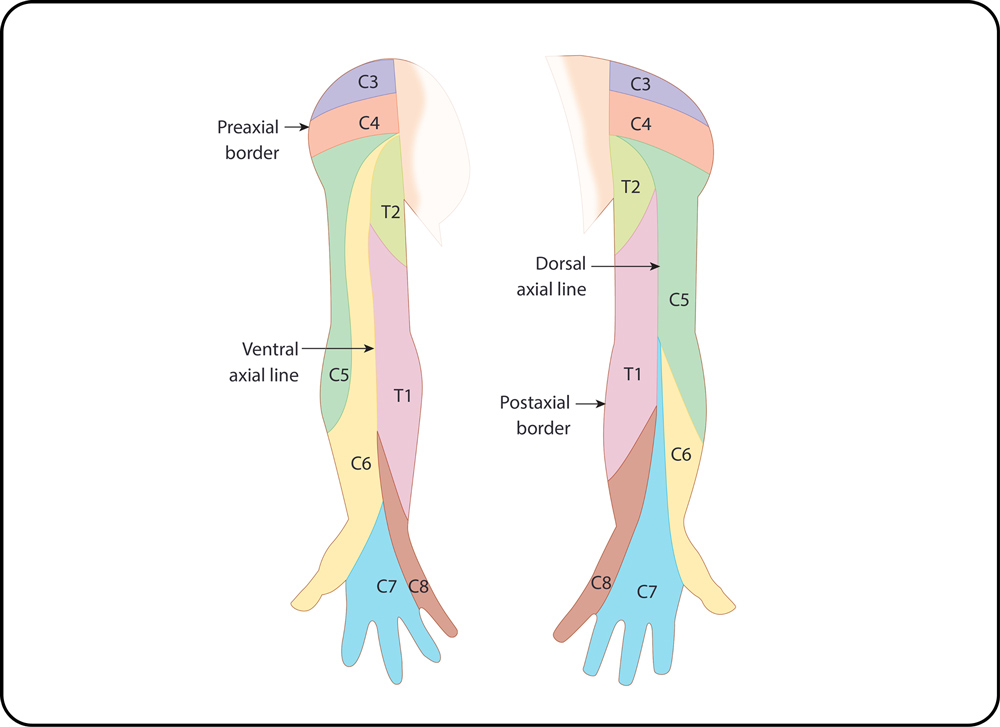
When affected, each cervical dermatome causes different symptoms. Here is a breakdown of symptoms associated with each of them.
| Dermatome | Common Associated Symptoms |
| C2 | Headaches, scalp tenderness, neck stiffness |
| C3 | Tingling or discomfort along the side of the neck |
| C4 | Shoulder pain, difficulty shrugging |
| C5 | Shoulder weakness, numbness |
| C6 | Radiating pain from the neck to the thumb, and numbness |
| C7 | Tingling or pain in the middle finger, linked to disc herniations |
| C8 | Grip weakness, tingling in the hand, and inner arm |
Upper Extremity Dermatomes: What They Cover
Upper extremity dermatomes specifically refer to the skin areas on your fingers, hands, arms, and shoulders. The nerves connected to these dermatomes originate from the cervical (neck) and upper thoracic (chest) regions of the spinal cord. The dermatomes C3 to C8 and T1 fall under this category. If you experience pain, numbness, or tingling in your hand or arm, your doctor will treat the condition as per the dermatome chart.
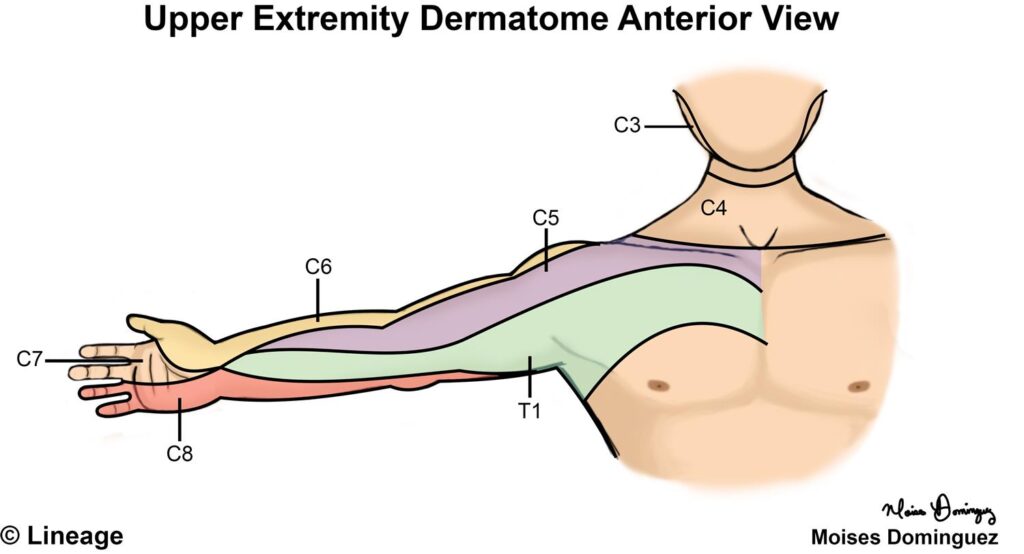
Thoracic Dermatomes: Band-Like Patterns on Chest and Back
Thoracic dermatomes are those areas of skin on your back, upper abdomen, and chest that get sensory inputs from the thoracic spinal nerves (T1–T12). Unlike the cervical dermatomes, the thoracic dermatomes form horizontal, band-like patterns wrapping your body from the back to the front, similar to a stripe pattern.
A Dermatome Man Representing the Thoracic Dermatomes
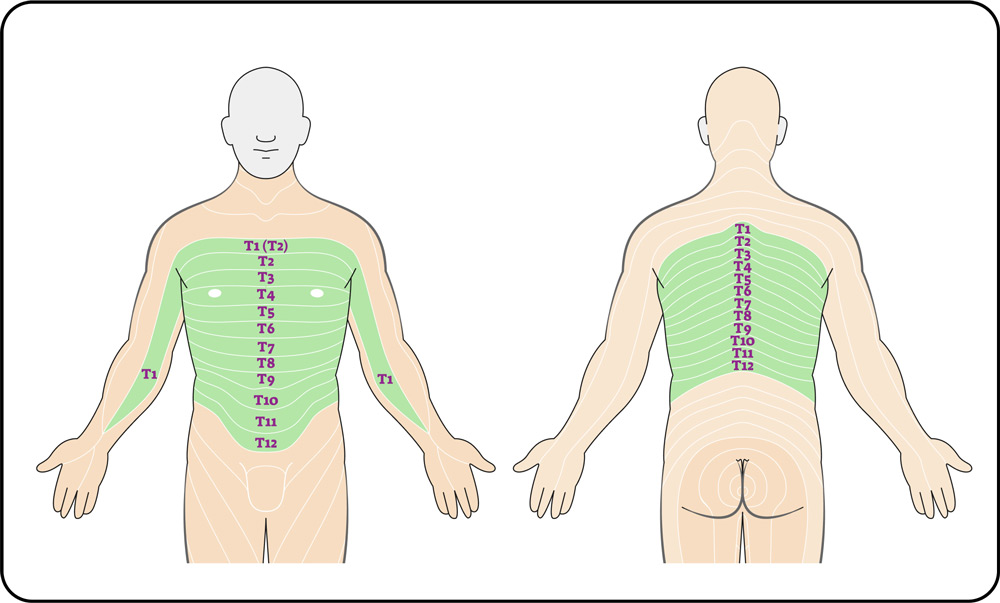
The following are the locations of each thoracic dermatome, as illustrated in the image:
| Dermatome | Body Region Covered |
| T1 | The chest and back area just above the armpits, and the inner side of the upper arm and upper forearm. |
| T2 | The upper back, just above the armpits and shoulder blades, and the inner side of the upper arm and chest. |
| T3 | The area of the chest and back at the armpit level, and the center of the shoulder blades. |
| T4 | The lower area of the pectoral muscles and the lower region of the shoulder blades. |
| T5 | The upper area of the chest, typically at or just below the nipple line. |
| T6 | The bottom edge of the breastbone, also called the sternum. |
| T7 | The lowermost part of the ribcage. |
| T8 | The upper part of the belly, including the top abdominal muscles. |
| T9 | The upper section of the back and the area just above the navel. |
| T10 | The center of the middle back and the area immediately below the navel. |
| T11 | The lower section of the back and the lower abdominal area, just above the pelvis. |
| T12 | The top of the hip region, just above the buttocks and groin. |
Lumbar Dermatomes: Lower Back, Thigh, and Knee
Lumbar dermatomes (L1 to L5) are those areas of the skin that receive sensory information from the lumbar spinal nerves. They cover the lower back, hips, and leg areas. These dermatomes play an important role in diagnosing spinal problems, nerve injuries, and conditions like sciatica and herniated discs.
Lumbar Dermatome Map: L1 to L5 Regions
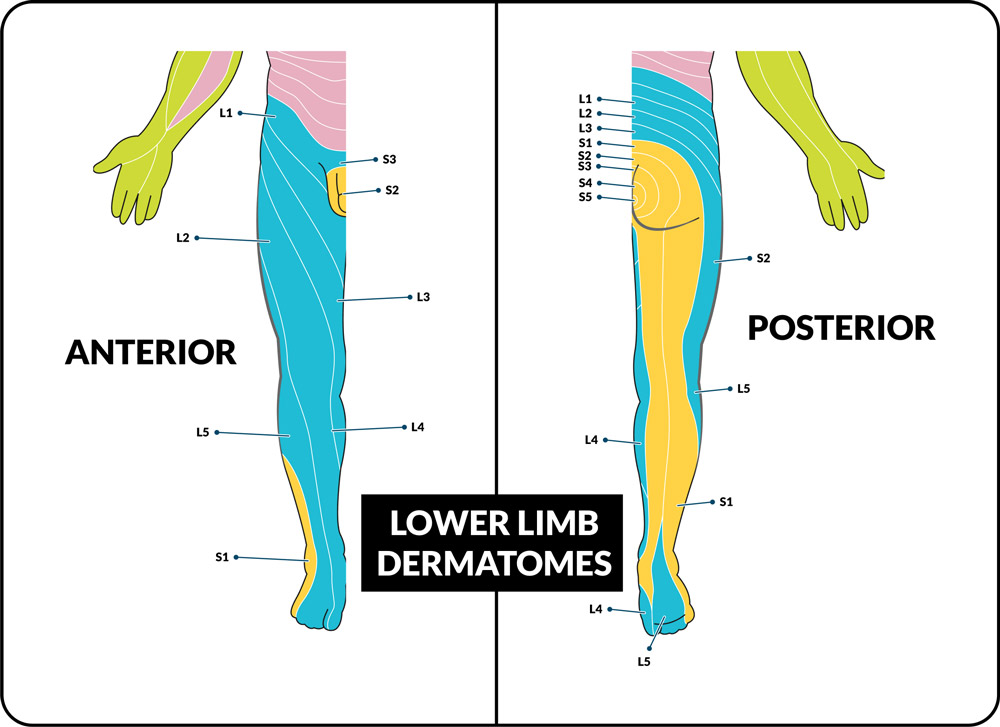
The following is an overview of how lumbar dermatomes are placed throughout the body.
➡️ L1 Dermatome: Groin and Upper Inner Thigh Region
The L1 dermatome is one of the first lumbar nerves involved in the lower body. It is associated with sensation in the lower abdomen and inner thigh area. It also covers the groin. Feelings of pain, tingling, or numbness in these areas could be related to the L1 spinal nerve. It can be affected by hip injuries or spinal problems.
➡️ L2 Dermatome: Mid Thigh and Upper Thigh Region
The L2 dermatome spreads through the upper and mid-thigh region on the front side of the body. Discomfort in the L2 area may feel like a sharp or burning pain down your thigh. This nerve may get impacted due to spine wear and tear or lower back compression. L2 plays a key role in transporting signals from the upper leg to the spine.
➡️ L3 Dermatome: Inner Thigh and Knee Region
The L3 dermatome spans the inner thigh across the front and inner region of the knee. L3 nerve irritation may cause pain, weakness, or tingling in this area. It often gets affected in conditions like spinal stenosis or herniated discs in the mid-lumbar spine. It helps with knee stability and leg bending.
➡️ L4 Dermatome: Inner Calf, Knee, and Big Toe Side of the Foot
The L4 dermatome starts at the outer thigh, spreads across the front of the knee, and continues downward to the inner side of the lower leg, ankle, and big toe. If you have discomfort in the big toe or shin, the L4 nerve may be involved. This nerve plays an important role in regulating knee strength and maintaining balance while walking.
➡️ L5 Dermatome: Outer Lower Leg and Top of the Foot
L5 starts from the outer part of the thigh, travels through the lateral side of the lower leg, and expands across the top of the foot to the middle toes. People with L5-related problems experience burning, tingling, or sharp pain in the big toe area or at the top of the foot. This nerve is essential for lifting the toes and foot, and is frequently involved in herniated disc problems.
➡️ Function and Clinical Insight Into Each Lumbar Dermatome
Each lumbar dermatome has a distinct function and clinical significance. The table below mentions both aspects of L1 to L5 dermatomes.
| Dermatome | Function | Clinical Insight |
| L1 | Sensation in the groin and hip crease | Irritation may cause burning pain or discomfort in the groin or pelvic area |
| L2 | Thigh sensation and hip flexion | Damage can cause numbness in the thigh or difficulty lifting the leg at the hip |
| L3 | Hip and knee movement; thigh adduction | Weakness when straightening or lifting the leg; can affect balance and gait |
| L4 | Knee stability and ankle support | Nerve compression may lead to knee buckling, reduced patellar reflex, or shin numbness |
| L5 | Foot dorsiflexion and toe extension | May cause foot drop, trouble lifting toes, and numbness on top of the foot |
Lower Extremity Dermatomes: What They Cover
Lower extremity dermatomes cover the toes, feet, calves, knees, thighs, hips, and legs, which are supplied by the spinal nerves from the lumbar (L1-L5) and sacral (S1-S5) regions of the spine.
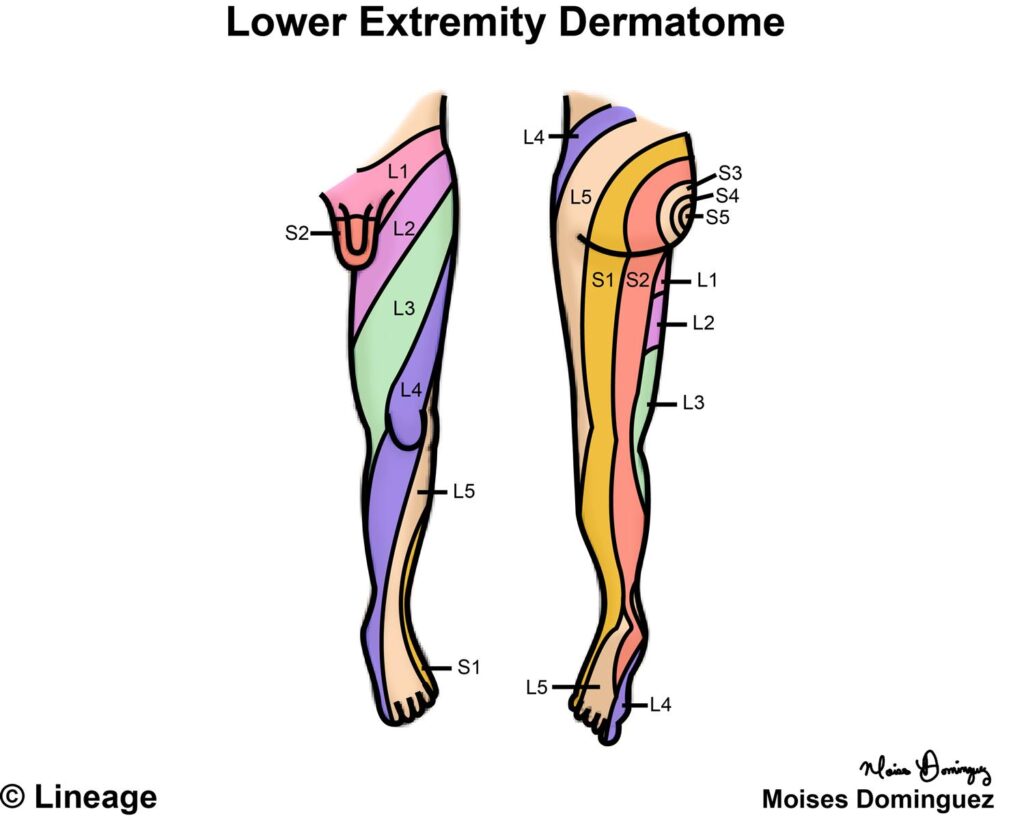
Facial Dermatomes: Understanding Sensory Nerve Distribution on the Face
Facial dermatomes are skin areas on the face supplied by sensory fibres from the trigeminal nerve. It is a special nerve that carries signals like pain, pressure, and temperature from the skin to the brain. Unlike other body parts, facial dermatomes are not mapped from spinal nerves.
The trigeminal nerve has three main branches, each one controlling a different part of your face:
- The first branch (V1) — controls the top of the nose, upper eyelids, and the forehead.
- The second branch (V2) — controls the upper teeth, upper lip, lower eyelids, and the cheeks.
- The third branch (V3) controls parts of the ears, the chin, the lower lip, and the lower jaw.
A Facial Dermatomes Chart
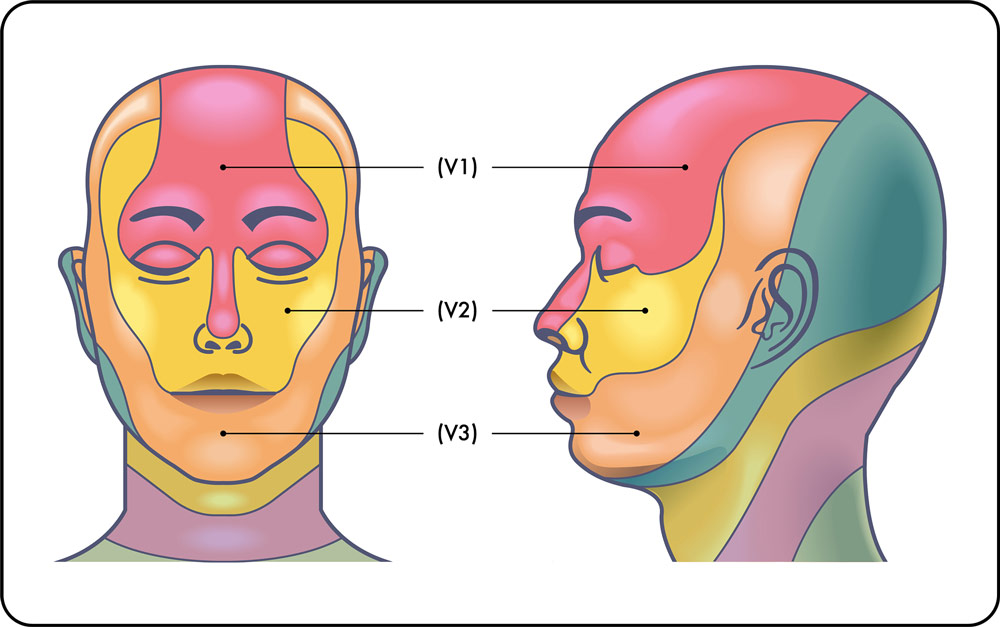
Facial dermatomes play a key role in determining what’s causing pain, numbness, tingling, or other forms of discomfort in your face. For example, if you have pain near one eye and a rash on your forehead, your doctor may suspect a nerve condition like shingles.
How Do Spinal Dermatomes Help in Diagnosing Various Health Conditions?
Spinal dermatomes act as a guide in understanding the nerve distribution throughout the body. When a nerve is irritated, injured, or compressed, it affects the body parts it’s connected to. This helps doctors and healthcare providers understand the root of the problem and thus identify the exact health condition.
Common Health Conditions Diagnosed Using Spinal Dermatomes
Here’s how different spinal nerves and dermatomes help identify specific health conditions:
| Spinal Dermatomes | Dermatomes Affected | Conditions Commonly Diagnosed |
| Cervical (C1–C8) | Neck, shoulders, arms, hands | Cervical radiculopathy, herniated disc, carpal tunnel syndrome, thoracic outlet syndrome |
| Thoracic (T1–T12) | Chest and abdomen | Shingles, intercostal neuralgia, spinal cord injury, referred cardiac pain |
| Lumbar (L1–L5) | Hips, thighs, knees, inner legs | Sciatica, lumbar disc herniation, spinal stenosis, meralgia paresthetica |
| Sacral (S1–S5) | Back of legs, feet, pelvic area | Cauda equina syndrome, pelvic nerve compression, diabetic neuropathy, foot drop |
The dermatome map helps doctors speed up diagnosis and ensure that the patient undergoes the correct tests, like CT scans, MRIs, and nerve conduction studies, at the right time.
While precise diagnosis is incredibly helpful, the reality is that treatment costs for nerve-related conditions vary greatly. Some conditions may resolve with medication or physical therapy, but others may require long-term rehabilitation, surgery, or specialised pain management, all of which are expensive. For instance,
- The treatment cost for Sciatica, a condition associated with lumbar dermatomes, can range from USD 20,000 to USD 90,000, including pre- and post-op care.
- Patients with diabetic peripheral neuropathy (DPN) incur an average of $25,000 per year in total medical expenses.
This financial strain may be distressing for you if you or a loved one is already going through physical pain.
Making Treatment Affordable With Flexible Payment Plans by Denefits
Denefits allows you to break down the costs associated with dermatome-related health conditions into affordable monthly payments without a credit check. Whether you need to see a specialist, get an MRI, or start nerve therapy, Denefits ensures that finances are not a barrier to your health.
Here’s what Denefits offers:
- No credit checks
- Flexible payment terms
- Quick application process completed within minutes
- Helps you start treatment immediately
Summing It All Up
Understanding dermatomes gives patients and providers a clearer idea of how spinal nerves affect sensation, pain, and movement across the body. The spine is divided into dermatomal regions—cervical, thoracic, lumbar, sacral, and coccygeal. These spinal dermatomes, from C1 to S5, play a distinct role in regulating specific body parts by allowing an exchange of sensory information.
The diagnosis is only half the battle; the next challenge is affording the recommended treatment, especially when it involves ongoing care, therapy, or surgery. That’s where Denefits can be beneficial as a financing solution, allowing you to pay with flexible payment plans without undergoing credit checks.

Frequently Asked Questions (FAQ) About Dermatomes and Nerve Maps
1. Is It Dermatones or Dermatomes?
It’s dermatomes — with an “m”, not an “n”. Dermatones is a common misspelling that many people use when searching online. So, if you typed “dermatones”, don’t worry. You’re likely looking for dermatomes, which are the areas of skin on your body connected to specific spinal nerves.
2. What Do Anterior and Posterior Mean in the Human Body?
The terms “anterior” and “posterior” are used in human anatomy to describe the direction of the body. In simple terms, anterior means the front side of the body, and posterior means the back side of the body.
3. What Are Arm Dermatomes and Leg Dermatomes?
The arm dermatomes (C5 to T1) include the shoulder, upper arm, forearm, hands, and fingers. The leg dermatomes (L1 to S2), on the other hand, include the toes, feet, ankles, calves, knees, and thighs.
4. What Are the Common Conditions Affecting Dermatomes Leg Areas?
Several conditions may affect the leg dermatomes, causing symptoms such as tingling, burning, numbness, or pain. Common conditions include sciatica, herniated disc, nerve root compression, spinal stenosis, and shingles (Herpes Zoster).
5. Which Spinal Nerves Control the Hand Dermatomes?
The hand dermatomes are primarily controlled by the C6, C7, and C8 dermatomes.
6. What Does LE Dermatomes Stand For?
“LE dermatomes” stands for “lower extremity” dermatomes. It’s a common short form commonly used in medical notes or charts to describe the areas of the legs and feet that get sensory signals from the lower spinal nerves.
7. How Do Dermatomes Lower Extremity Patterns Affect Sensation?
The lower extremity patterns of dermatomes describe how the skin on the feet, calves, knees, thighs, and legs is divided into zones, each of which is innervated by a specific spinal nerve. These patterns are like a sensory map. For example, if the L5 dermatome is affected, you might feel symptoms on the top of your foot or in your toes.
8. How Can Dermatomes Upper Extremity Testing Help With Arm or Hand Pain?
Dermatomes upper extremity testing helps doctors understand the reasons behind hand or arm pain by identifying the affected spinal nerve. The upper extremity encompasses your shoulders, forearms, arms, hands, and fingers. Here are a few examples:
- Tingling in the middle finger could mean an issue exists with the C7 nerve.
- Pain in the thumb may correspond to the C6 dermatome.
- Numbness in the little finger might indicate that the C8 dermatome needs attention.
9. What Is the L5 Myotome and What Does It Control?
The L5 myotome is a group of muscles controlled by the L5 spinal nerve originating from the lower back. The L5 myotome is responsible for movements such as:
- Lifting feet upward
- Extending the big toe
- Folding the foot inward
- Controlling side-to-side leg movement at the hip
When the L5 myotome is compressed or injured, you may experience weakness in the feet or toes, especially when trying to lift them off the ground. This may lead to a condition known as foot drop, where the patient has trouble walking properly because the foot feels floppy or drags.
10. What Is the “Four Fingers Up” Meaning in Myotome Testing?
In myotome testing, the “four fingers up” technique allows doctors to evaluate the strength and function of the C8 spinal nerve. This nerve controls finger extension and grip release.
During a neurological exam, your doctor may ask you to raise or spread four fingers (without the thumb) to assess whether the C8 myotome is functioning properly. This movement validates whether the nerve is efficiently transporting signals from the spinal cord to the hand and fingers.
11. What Is the S1 Dermatome and What Does It Control?
The S1 dermatome receives information from the S1 spinal nerve, located in the sacral region in the lower part of the spine. It typically includes the outer side of the foot, the heel, and the back of the leg and calf.
12. Do I Need Good Credit To Qualify for Denefits?
No, Denefits does not require a credit check to finance your treatment costs. It has one of the highest approval rates for healthcare financing.
13. What if I Don’t Have Insurance, or My Plan Doesn’t Cover Everything?
That’s exactly what Denefits is built for. If you’re uninsured or facing high deductibles, Denefits helps you afford high out-of-pocket medical costs without delay.
The post Dermatomes: Your Simple Guide to the Nerve Map on Your Skin first appeared on Denefits.







